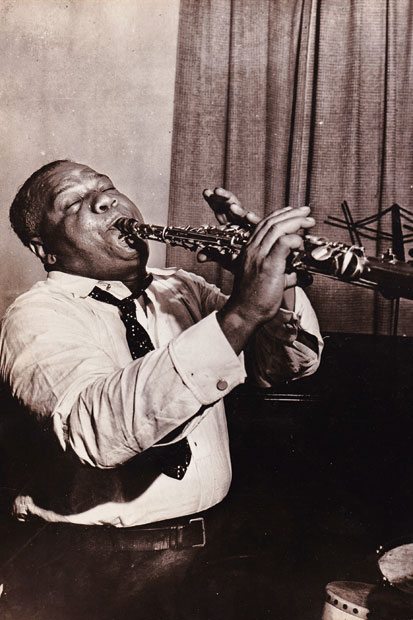This is a big book, a monumental text with 800 illustrations, 400 of them in colour, to be contemplated more easily on a lectern than in bed, celebrating the 75-year history of the greatest record company devoted solely to the variegated music called jazz.
Blue Note Records, with headquarters in Manhattan, originated in the romantic imagination of a privileged adolescent, a Jewish architect’s son (the Jewishness was significant), who was born and brought up in Christopher Isherwood’s neighbourhood in Berlin, which regarded itself, with justification, as Europe’s capital of jazz in the hedonistic heyday of the Weimar republic. Alfred Lion precociously consorted with the city’s artists, musicians and all-round bohemian intellectuals. In his early teens there he admired Sam Wooding’s American band in the Chocolate Kiddies revue; and Alfred’s mother introduced him to Sidney Bechet, the black American clarinet and soprano saxophone virtuoso, who took New Orleans jazz to Germany in the 1920s.
Alfred visited the United States on his own at the age of 18, in 1926, returned to Berlin, and settled in New York soon afterwards, a few years before the Nazis anathemised jazz as the decadent music of negroes managed by Jews that Goebbels said threatened to corrupt the culture of German youth.

In New York in the 1930s entertainment was racially segregated, notably in Harlem’s Cotton Club, where Duke Ellington first became famous in the black cabaret, whose patrons were all white, by order of the gangsters who owned the place. Network radio stations broadcast jazz from the Cotton Club, the Savoy Ballroom and New York’s hotels, where white swing bands played between coast-to-coast tours. By the late 1930s jazz records could be heard for a nickel a spin in America’s 200,000 juke boxes.
One of the jazz venues frequented by young Alfred was Café Society, a downtown nightclub which was the first to present black and white musicians together for an unrestricted black and white clientele. It was there that he again encountered Sidney Bechet and heard Meade Lux Lewis, Albert Ammons and Pete Johnson, the masters of boogie-woogie piano; and it was with the club’s band that Billie Holiday recorded ‘Strange Fruit’, that haunting song about lynching in the Deep South. Alfred had already marvelled at Lewis, Ammons and Johnson at a Carnegie Hall concert that presented black music from gospel to the latest jazz, organised by John Hammond, the influential (white) jazz critic and spotter of talented musicians, such as Count Basie and Lady Day herself. Hammond gave his acquaintance Alfred a complimentary ticket to the concert. Years later he recalled, ‘John Hammond is really responsible for my getting started without him even knowing it.’

Alfred earned a reputation for perfectionism in all aspects of production, commissioning only musicians whose work he really enjoyed and counting on occasional financial successes to subsidise avant-garde experiments he knew were unlikely to make much money. During the years of long-playing records, Blue Note album covers, designed by Paul Bacon and Reid Miles, were celebrated for the artistic originality of their typography and portraiture. The most distinguished photographs were by Francis Wolff, Alfred’s best boyhood friend, also Jewish, who got out of Germany at the last possible moment, immediately after the outbreak of the second world war, to become an important collaborator in Blue Note’s development.Soon after the concert, Alfred went to Café Society to persuade the boogie-woogie pianists to let him record them for his new record label, though it was somewhat short of funds and as yet unnamed. Meade Lux Lewis’s only question was whether they would be paid. Alfred promised they would; and, for further encouragement, he made sure there was a bottle of whisky on the piano in the rented studio. Lewis played his Honky Tonk Train Blues and other impressive numbers on 6 January 1939 to get Blue Note Records well under way. Since then, the company has always been known to pay musicians fairly, even for days of rehearsal, a practice not universal in the early days.
In the beginning was the manifesto, written by Max Margulis, one of Blue Note’s early advisers:
Blue Note Records are designed to serve the uncompromising expression of hot jazz or swing. Direct and honest hot jazz is a way of feeling, a musical and social manifestation, and Blue Note are concerned with identifying its impulse, not its sensational and commercialised adornments.
Even after Alfred Lion retired many years later and there were changes of corporate ownership, successive presidents of the company, including the incumbent Don Was, have sworn to uphold the original standards. As a result, Blue Note has been able to attract many leading radical jazz innovators — Thelonious Monk, Miles Davis, John Coltrane, Dexter Gordon, Art Blakey, Ornette Coleman, Herbie Hancock, Wayne Shorter, Horace Silver and on and on, from bebop to fusion, free jazz, acid jazz and jazz rock.
Richard Havers, a prolific author of books on jazz, who writes in an amiably informal style, expertly shows how mainstream jazz, since Blue Note recorded Bechet, has broadened into a delta, in which jazz is a loosely defined subjective concept. When Blue Note recently recorded the mellifluous voice of Norah Jones, a sitar player’s daughter, singing ‘Come Away With Me’, the record became the company’s biggest commercial success of all time, selling more than 25 million copies worldwide. Havers acknowledges that critical purists have complained that Norah Jones’s singing, though excellent in its way, is not jazz, but he responds, in the laissez-faire aesthetic spirit of today, ‘Who cares and does it matter?’ I do and I think it does.






Comments